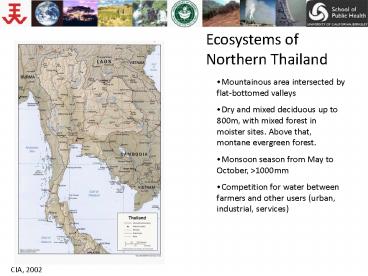CIA, 2002 - PowerPoint PPT Presentation
1 / 11
Title:
CIA, 2002
Description:
The Hmong have settled in the province of Chiang Mai and villages can be visited near Doi Suthep and Doi Inthanon. Their succession is patrilineal (of, ... – PowerPoint PPT presentation
Number of Views:99
Avg rating:3.0/5.0
Title: CIA, 2002
1
Ecosystems of Northern Thailand
- Mountainous area intersected by flat-bottomed
valleys - Dry and mixed deciduous up to 800m, with mixed
forest in moister sites. Above that, montane
evergreen forest. - Monsoon season from May to October, gt1000mm
- Competition for water between farmers and other
users (urban, industrial, services)
CIA, 2002
2
- Ethnic Thais as well as hill tribes clear forest
for cultivation in the uplands - Upland farming widespread and diverse
- Hillside orchards (permanent removal of forest
cover) - Established swiddening (with long term fallow and
forest harboring high biodiversity) - Pioneer swidenning (modifying the land cover in
the long term)
CIA, 1974
3
Hill tribes in Thailand
- A term used in Thailand for all of the various
tribal peoples who migrated from China and Tibet
over the past few centuries. - They now inhabit the remote border areas between
Northern Thailand, Laos and Burma (Myanmar). - These areas are known for their thick forests
and mountainous terrain. - The six major hill tribes within Thailand are the
Akha, Lahu, Karen, Hmong, Mien and Lisu, each
with a distinct language and culture.
4
Karen
- Population approx 300,000
- Origin Myanmar
- The largest of the minority groups
- Unmarried women wear distinctive long white
v-neck tunics. - The Karen occupy lowland areas, engaging in
agriculture, including rice cultivation. - They are also skilled weavers and the most
environmentally conscious of the hill tribes -
practicing crop rotation, thus preserving the
forest.
5
Lahu
- Population approx 73,000
- Origin Yunnan, Myanmar
- Also known as Musor
- Concentrated near the Burmese border
- A reputation as excellent hunters, and survive
off vegetable cultivation, with some
supplementing with opium production.
6
Hmong
- Population approx 124,000
- Origin Yunnan
- The second-largest hill tribe group
- Sometimes referred to as Meo.
- They are largely animistic and best known for
their intricate embroidery. - Known to be fiercely independent and with nomadic
tendencies, they sided with communist rebels in
Thailand in the 1970s - Settled in the province of Chiang Mai
- Their succession is patrilineal and polygamy is
widely practiced.
7
Lisu
- Population approx 28,000
- Origin Tibet / Yunnan
- Occupying villages above 1,000m
- Keep livestock and cultivate corn and vegetables.
- Unlike other hill tribes, they don't usually live
in stilted houses. - Also recognized as some of the most physically
attractive of the hill tribes and marriage
outside of their tribe is not uncommon.
8
Akha
- Population approx 50,000
- Origin Tibet / Myanmar
- The Akha are among the most down-trodden and
often most impoverished of the hill tribes,
resisting assimilation into mainstream Thai
culture. - The most fascinating and colourful of the hill
tribes - Can easily be visited, particularly in Chiang Rai
province. - Came to Thailand in the early 20th century,
mainly due to their persecution in Burma. - Opium is still used among this tribe.
9
Mien
- Population approx 40,000
- Origin Central China
- Also known as the Yao
- They are distant linguistic relatives of the
Hmong and originated from China. - Being the smallest group, the Mien live in
isolated villages, mostly in and around Chiang
Rai and Nan.
10
Livelihood
- Until recently, the hill tribes were subsistence
farmers, who used slash and burn agricultural
techniques to farm their heavily forested
communities. - Tighter conservation of Thailand's virtually
depleted forests, however, has forced hill tribe
people to abandon their traditional agricultural
methods. - Traditionally, hill tribes were also a migratory
people, leaving land as it became depleted of
natural resources.
11
Political status
- They were pretty much left alone until the 1950s,
when the increase in their numbers, extreme
poverty, statelessness and threat of insurgency
forced the Thai government to establish the
National Committee for the Hill Tribes.































